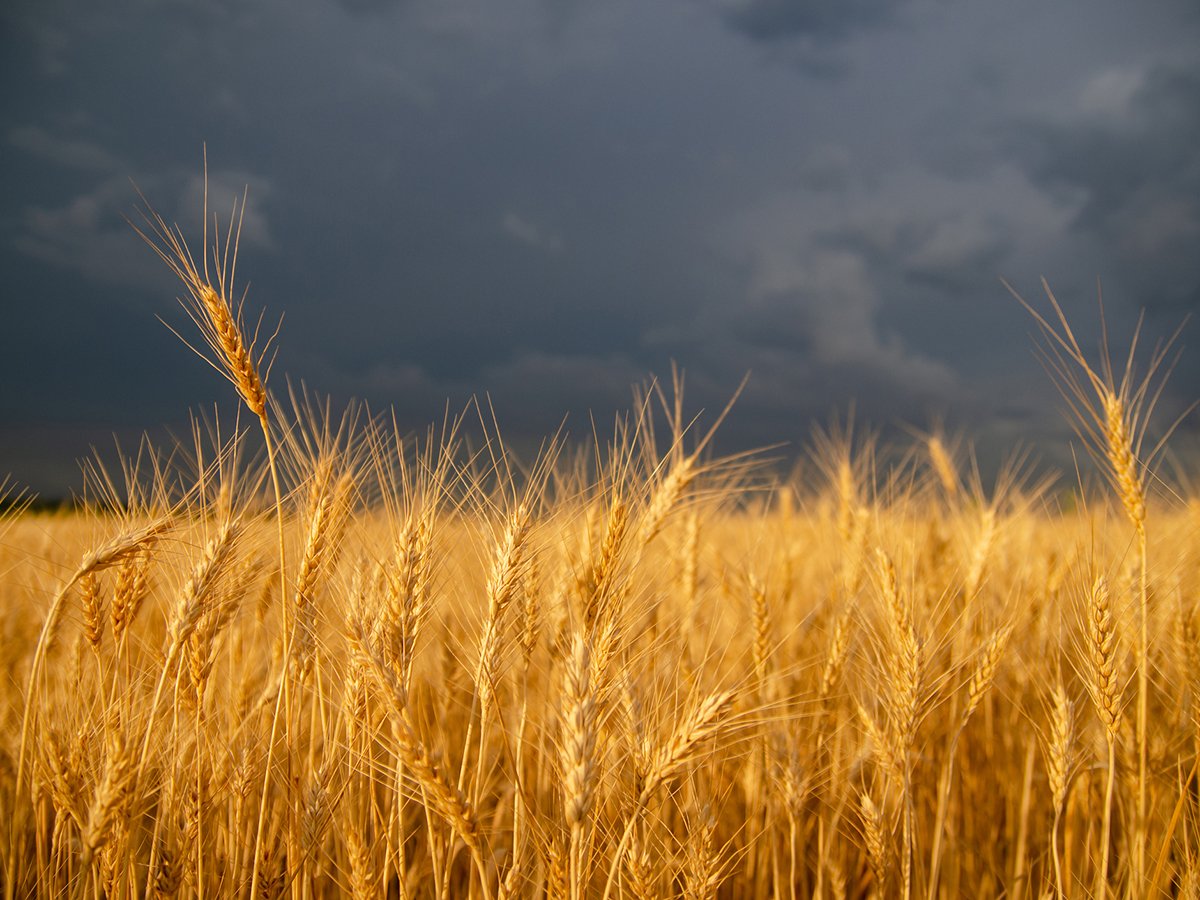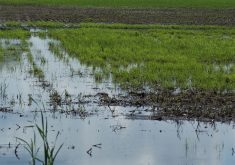Picking berries, filleting fish
On the long weekend in August, we had an opportunity to celebrate our friends’ 30th wedding anniversary at their fishing camp called Trail North at Bunn Island north of LaRonge.
Wild blueberries picked fresh in the morning for our breakfast pancakes and fresh fish deboned and filleted for a fish fry for supper have inspired me to write about culinary delights in northern experiences.
We will treasure reflections of the natural rugged beauty of the northern world that our friends introduced to us this weekend: The wide expanse of water and trees, the smell of the cedar when out on the lake, the sounds of the loons and the squirrel, the quietness (when the generator is shut off for the night), the taste of fresh berries and fish, the feel of the cold water splashing, and the thrill of reeling in jack, pickerel and trout.
Read Also

Late season rainfall creates concern about Prairie crop quality
Praying for rain is being replaced with the hope that rain can stop for harvest. Rainfall in July and early August has been much greater than normal.
We will always remember the warm, friendly and fun-loving atmosphere. The laughter of the card-playing young and old, storytelling, jokes played on each other and ghost stories by the campfire. Snacking on fish smoked in a brown sugar brine, nibbling on wild raspberries, blueberries and cranberries, eating David’s rendition of lobster (perhaps better than the real thing) and Nan’s delicious saskatoon pies (brought from home) all helped to create this unforgettable fishing camp experience.
Filleting, deboning fish
Part of this experience was, of course, filleting and eating the fish. If you like fish, but don’t like bones, debone the fish before you cook it by using a very sharp, flexible-bladed boning knife. To do this, David leaves the head because it is easier to hang onto the slippery fish.
He starts just behind the gills, and cuts behind the head down the centre of the back on a diagonal line just back of the gills to the backbone, making a slit from the top of the fish to the bottom, making sure not to cut too deeply. Taking the knife from head to tail along the backbone between ribs and flesh, remove the rib bones. Take the rib bones out by peeling them off with a knife, and discard.
To separate the filet from the fish, turn the knife and slice along the backbone to the tail, cutting the filet loose from the fish at the tail. Turn the fish over, and repeat the same procedure.
To continue to debone, make two cuts along top and bottom of Y-bones, parallel to these bones, and pull out the strip of Y-bones.
Next, take off the skin. Insert the fillet knife at the tail and slice fillet meat from the skin. The rule is one must leave a small amount of hide attached to the fish for identification by the warden.
Freshly caught fish taste best when cooked soon after catching. Fish is best cooked quickly, a short time at high temperature. Overcooking dries and toughens naturally tender fish flesh. Allow 10 minutes cooking time per inch of fresh fish thickness.
Fish is cooked when it pierces easily to a fork, separates readily into flakes and the flesh loses its raw wet look and appears milky and opaque instead. Serve immediately.
David’s “lobster”
1 cup vinegar 250 mL
1Ú2 cup salt 125 mL
5 pounds pickerel 2.5 kg
8-10 cups water 2-2.5 L
Put vinegar, salt and water in a pot, and heat to boiling point. Add pickerel and cook until the fish rises to the top, and is opaque or white in color. Serve. Dip it in melted butter for a great taste!
Wild rice
LaRonge is also well-known for its wild rice which grows in shallow waters (15 centimetres to one metre deep) along the shores of northern lakes, rivers and streams. Wild rice is a tall, grass-like plant growing annually from seed. The flowers are often purple with bright yellow stamens. Grains are long, dark, grayish-brown and ripen in mid-September. Before the grain is edible, the hulls must be removed by pricking and rubbing.
Wild rice has a distinctive nutty flavor and a soft chewy texture that makes it a culinary delight. It is a nutritious organic food high in fibre, low in fat, rich in proteins, minerals and B vitamins. The average serving has only 70 calories. One half pound serves 12 people. Saskatchewan wild rice expands four times in volume.
To cook wild rice, place it in a wire strainer and wash with cold water. Then bring rice to a boil in a pan of salted water, using 1 cup (250 mL) rice, 4 cups (1 L) water, and 1 teaspoon (5 mL) salt. Cover and reduce heat to simmer for about 50 minutes, or until the kernels are tender or puff open to reveal the white interior. Stir occasionally to prevent sticking. Remove from heat and drain.
For fluffier rice and more servings per pound, let rice stand in the hot cooking water for 20-30 minutes, then drain, rinse, and drain again. Serve hot with butter and salt.
Cooked wild rice can be frozen, or stored in an airtight container in the refrigerator for up to two weeks.
Wild rice enhances almost any dish, from meats, fish and game, to casseroles, soups, salads, breads, snacks and even desserts. Try wild rice in scrambled eggs, hash browns, pancakes, muffins and ice cream toppings.
For a free wild rice recipe booklet, write to: Saskatchewan Wild Rice Council, Inc., Box 1710, LaRonge, Sask., S0J 1L0 or phone 306-425-3848.
Stir-fried wild rice
1Ú2 cup chopped 125 mL
onions
1Ú4 cup thinly sliced 50 mL
celery
1Ú2 cup mushrooms 125 mL
1Ú4 cup water 50 mL
1 tablespoon butter 15 mL
or margarine
1 teaspoon cornstarch 5 mL
1 cup cooked, 250 mL
chopped meat (chicken, pork, or beef)
1Ú2 teaspoon seasoning 2 mL
salt
5 cups cooked wild 1.25 L
rice
Stir fry onions, celery and mushrooms in butter or margarine until tender. Add cooked wild rice, meat and seasoning salt. Mix water and cornstarch, add to above ingredients and beat until thickened. Serve.
Wild rice is available in many grocery stores and restaurants.
Campfires
We also learned more about building fires this weekend. Your cooking fire, the hot coals of wood, make food tastier. Building a safe, satisfactory fire requires attention to certain details.
Place two logs on a grate about 15 cm apart and lay tinder or crumpled scrap paper between them. Put a handful of twigs or softwood kindling above this. Place larger twigs and sticks over this base, crisscrossing them to provide air spaces and draft between. Light the tinder and add large logs, as needed.
For a fast fire to quick-boil and broil things, use split dry balsam, spruce, white pine or cedar. For a steady burning fire, use jack pine, chestnut, aspen or maple. For long-lasting broiling coals, use ash, oak, hickory or tamarack. Fires built entirely of softwoods burn too quickly. A combination of softwoods and hardwoods (birch, maple and oak) will make an easily ignited and long-lasting fire.
To put out the fire, use fire tongs to stand partially burned logs on end in the back corners of the fireplace or fire pit. Rake coals and ashes toward the front of the grate or fireplace after each use. Ash should be allowed to accumulate to a depth of four centimetres because it concentrates the heat and directs a draft up to the base of the fire.
Dandelion, grass control
In response to M.B., Grenfell, Sask. who asked for help to control dandelions and grass in raspberries, E.G., Porcupine Plain, Sask. and V.T., Spiritwood, Sask. report good results using fall application of a granular product called “Casoron” which is available in small bags or plastic containers.
Greenish tint on potatoes
Have you noticed a greenish tint on your garden potatoes or store-bought potatoes? This occurs when the tubers are exposed to either sun or artificial light. The color is due to the chlorophyll developed in the skin. Along with this color change, the solanin content in the potato increases. Solanin, a bitter compound, is generally concentrated close to the potato’s surface and is easily removed when peeled. There is little concern about solanin being harmful unless eaten in very large quantities, and it is not accumulated in the body.
Hilling potatoes in the garden from the sun can help to avoid this greening. After potatoes are gathered, store in a dark, cool and well-ventilated area. Avoid storing in plastic bags, and do not refrigerate.
Source: The Fresh for Flavour Foundation, 310 – 1101 Prince of Wales Drive, Ottawa, Ont., K2C 3W7, 613-226-4187 or fax: 613-226-2984.

















